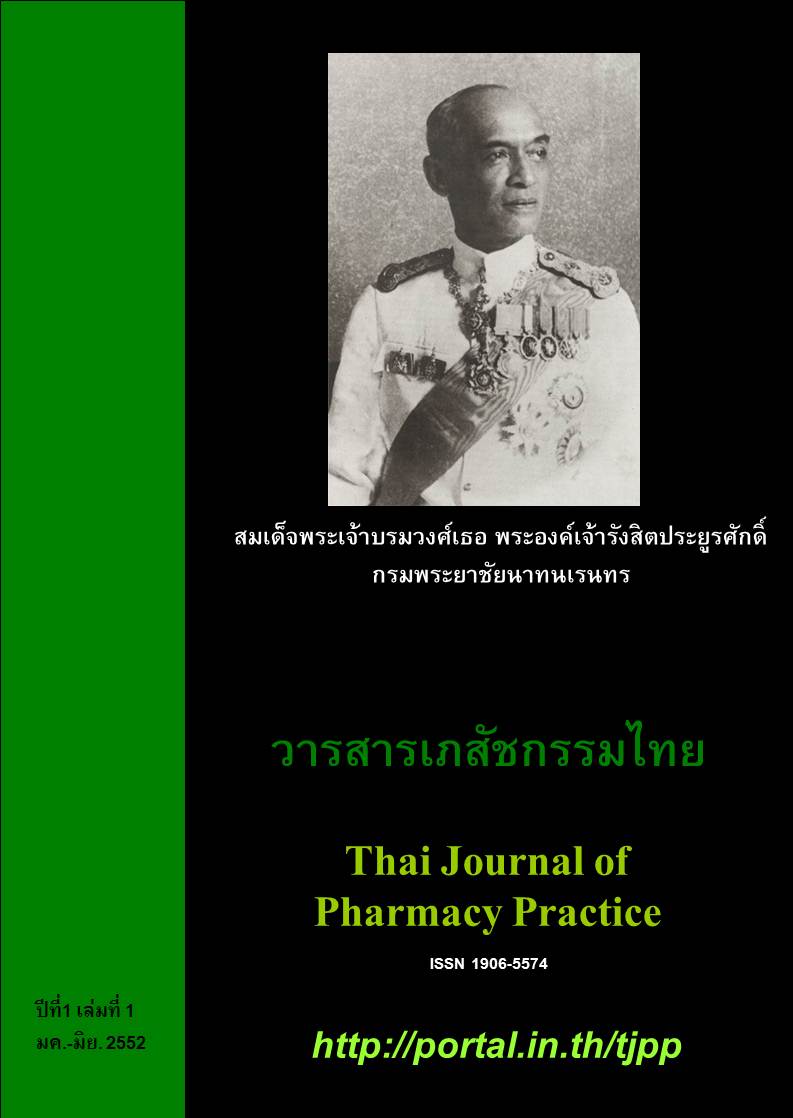คุณสมบัติของแบบวัดตัวแปรจิตลักษณะตามแบบจำลองข้ามทฤษฎีในผู้สูบบุหรี่
Main Article Content
บทคัดย่อ
วัตถุประสงค์ : เพื่อทดสอบความตรงและความเที่ยงของแบบวัดตัวแปรตามแบบจำลองข้ามทฤษฎีสำหรับผู้สูบบุหรี่ วิธีการศึกษา : ผู้วิจัยวัดตัวแปรที่ชื่อว่าขั้นตอนของการเลิกบุหรี่ ความเห็นในเรื่องข้อดี-ข้อเสียของการสูบบุหรี่ และความหวั่นไหวเมื่อมีสิ่งยั่วยุให้สูบบุหรี่โดยใช้แบบวัดของ Velicer และคณะ ส่วนการวัดกระบวนการเปลี่ยนแปลงใช้แบบวัดของ Prochaska และคณะ แบบวัดทั้งหมดถูกแปลเป็นภาษาไทยโดยวิธีการแปลและแปลกลับ ผู้วิจัยเก็บข้อมูลโดยใช้แบบสอบถามชนิดตอบเองจากตัวอย่างตามสะดวก 330 รายจากผู้ที่สูบหรือเคยสูบบุหรี่ซึ่งเป็นพลทหารกองประจำการในค่ายทหารแห่งหนึ่งในภาคใต้ หรือผู้ป่วยชายในแผนกผู้ป่วยนอกหรือข้าราชการทหารที่มาตรวจสุขภาพประจำปีในโรงพยาบาลที่สังกัดค่ายทหารดังกล่าว ผลการศึกษา : ผู้สูบบุหรี่ในการวิจัยนี้อยู่ในขั้นไม่ได้คิดถึงการเลิกบุหรี่ ขั้นคิดว่าจะเลิกและขั้นเตรียมพร้อมในการเลิกร้อยละ 50.00, 32.14 และ 17.86 ตามลำดับ แบบวัดความเห็นในเรื่องข้อดี-ข้อเสียของการสูบบุหรี่มี ความตรง-ความเที่ยงดีอยู่ในระดับที่น่าพอใจเหมือนแบบวัดต้นฉบับ แบบวัดความหวั่นไหวฯ วัดตัวแปรย่อยได้สองตัวคือความหวั่นไหวจากการกระหายบุหรี่และสถานการณ์ที่สบายใจ และความหวั่นไหวจากวิกฤติด้านอารมณ์ แบบวัดตัวแปรทั้งสองมีความตรงและความเที่ยงเป็นที่น่าพอใจ การวิเคราะห์องค์ประกอบเชิงสำรวจสำหรับแบบวัดกระบวนการเปลี่ยนแปลง 10 แบบนั้นพบว่ามีเพียง 4 แบบวัดเท่านั้นซึ่งคำถามเกาะกลุ่มเป็นไปตามผลการวิจัยในอดีต สรุป : แบบวัดขั้นตอนการเลิกบุหรี่ ความเห็นในเรื่องข้อดี-ข้อเสียของการสูบบุหรี่ และความหวั่นไหวฯ ฉบับภาษาไทยในการศึกษานี้มีความตรงและความเที่ยงที่ดี สามารถนำไปใช้ประเมินผู้สูบบุหรี่เพื่อให้ได้ข้อมูลประกอบคำแนะนำในการเลิกบุหรี่ อย่างไรก็ตาม แบบวัดกระบวนการเปลี่ยนแปลงต้องได้รับการพัฒนาและปรับปรุงอย่างมากก่อนนำไปใช้
Article Details
ผลการวิจัยและความคิดเห็นที่ปรากฏในบทความถือเป็นความคิดเห็นและอยู่ในความรับผิดชอบของผู้นิพนธ์ มิใช่ความเห็นหรือความรับผิดชอบของกองบรรณาธิการ หรือคณะเภสัชศาสตร์ มหาวิทยาลัยสงขลานครินทร์ ทั้งนี้ไม่รวมความผิดพลาดอันเกิดจากการพิมพ์ บทความที่ได้รับการเผยแพร่โดยวารสารเภสัชกรรมไทยถือเป็นสิทธิ์ของวารสารฯ
เอกสารอ้างอิง
2) World Health Organization. Tobacco Control Country Profiles [online]. 2003 [cited 2008 Jul 15]. Available from URL: http://www.who.int/tobacco/global_data /country_profiles/en/index.html
3) ศรัณญา เบญจกุล, มณฑา เก่งการพานิช, ลักขณา เติมศิริกุลชัย, ณัฐพล เทศขยัน. สถานการณ์การบริโภคยาสูบของประชากรไทย พ.ศ. 2543-2549. กรุงเทพฯ: เจริญดีมั่นคงการพิมพ์; 2550.
4) Hughes JR. Combined psychological and nicotine gum treatment for smoking: a critical review. J Substance Abuse 1993;3:337–50.
5) Nelson E. The miseries of passive smoking. Hum Exp Toxicol 2001;20:61-83.
6) สมหญิง พุ่มทอง. ยาและการเข้าถึงยาเพื่อการเลิกบุหรี่ในประเทศไทย. ไทยเภสัชศาสตร์และวิทยาการสุขภาพ 2551; 3:303-8.
7) Curry SJ. Self-help interventions for smoking cessation. J Consult Clin Psychol 1993; 61:790–803.
8) Schmid TL, Jeffrey RW, Hellerstedt WL. Direct mail recruitment to house-based smoking and weight control programs: a comparison of strengths. Prev Med 1989;18:503–17.
9) Fiore MC, Bailey WC, Cohen SJ, Dorfman S, Goldstein M, Gritz E, et al. Smoking cessation clinical practice guideline No. 18. Rockville (MD): US. Department of Health and Human Services, Agency for Health Care Policy and Research; 1996 Apr. Publication No. 96-0692.
10) The COMMIT Research Group. Community intervention trial for smoking cessation (COMMIT): II Changes in adult cigarette smoking prevalence. Am J Public Health 1995; 85:193–200.
11) Glasgow RE, Terborg JR, Hollis JF, Severson HH, Boles SM. Take heart: results from the initial phase of a work-site wellness program. Am J Public Health 1995; 85:209–16.
12) Velicer WF, Fava JL, Prochaska JO, Abrams DB, Emmons KM, Pierce J. Distribution of smokers by stage in three representative samples. Prev Med 1995; 24:401–11.
13) Prochaska JO, DiClemente CC.. Stages and processes of self-change of smoking: toward an integrative model of change. J Consult Clin Psychol 1983;51:390–5.
14) Velicer WF, Prochaska JO. An expert system intervention for smoking cessation. Patient Educ Couns 1999;36:119–29.
15) Velicer WF, Prochaska JO, Fava JL, Norman GJ, Redding CA. Smoking cessation and stress management: Applications of the Transtheoretical Model of behavior change. Homeostasis 1998;38: 216-33.
16) Prochaska JO. Strong and weak principles for progressing from precontemplation to action on the basis of twelve problem behaviors. Health Psychol 1994;13:47-51.
17) Prochaska JO, Velicer WF, DiClemente CC, Fava JL. Measuring the processes of change: applications to the cessation of smoking. J Consult Clin Psychol 1988;56:520–8.
18) Velicer WF, DiClemente CC, Prochaska JO, Brandenberg N. A decisional balance measure for assessing and predicting smoking status. J Pers Soc Psychol 1985;48:1279-89.
19) Velicer WF, DiClemente CC, Rossi JS, Prochaska JO. Relapse situations and self-efficacy: An integrative model. Addict Behav 1990;15:271-83.
20) Guillemin F, Bombardier C, Beaton D. Cross-cultural adaptation of health-related quality of life measures: literature review and proposed guidelines. J Clin Epidemiol 1993;46:1417–32.
21) Bowen CW. Think-aloud method in chemistry education. J Chem Educ 1994;71:184-90.
22) MacCallum RC, Widaman KF, Zhang S, Hong S. Sample size in factor analysis. Psychol Methods 1999;4:84-99.
23) Centers for Disease Control and Prevention. Cigarette smoking among adults-United States, 1993. MMWR Morb Mortal Wkly Rep 1994;43:925-9.
24) Nunnally JC. Psychometric theory. 2nd ed. New York: McGraw-Hill; 1978.
25) Etter JF, Perneger T V, Ronchi A. Distributions of smokers by stage: International comparison and association with smoking prevalence. Prev Med 1997;26:580-5


